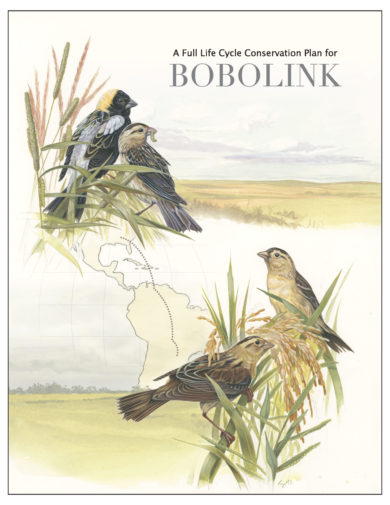For decades, grassland bird research and conservation happened in large part in the prairies and fields of North America. Yet for many grassland birds, particularly Bobolink, this was only half the story.
A Bobolink spends twice as much time in South America than in North America. It's why VCE studies Bobolinks wherever they go. And it's why the US Fish and Wildlife Service selected us to write the blueprint for the conservation of Bobolinks not only across North America, but South America as well—by gathering input from partners in both continents.
Like many grassland birds in North America, the Bobolink has suffered significant population declines due to threats that continue unabated. Our conservation options are limited on agricultural and other privately owned habitats.
In response to these and other challenges, the US Fish and Wildlife Service designated Bobolink as a focal species, and called for a conservation plan that would address threats to Bobolinks as well as other grassland bird species. With input from North and South American partners, this Bobolink Conservation Plan considers the “full life-cycle” of Bobolinks: north, south, and in migration.
Developing the plan for Bobolink challenged us to address not only ecological, but also socioeconomic factors affecting grassland birds. As a result of this work, we have strengthened our collaboration between North and South American partners. The Conservation Plan includes guidelines for carrying out cross-country coordinated conservation at multiple scales to meet population objectives set forth in the Plan.
A Full Life Cycle Conservation Plan for Bobolink
 VCE conservation biologist Rosalind Renfrew is the primary author of the Plan, but dozens of conservation professionals made major contributions to the overall Plan and to particular sections.
VCE conservation biologist Rosalind Renfrew is the primary author of the Plan, but dozens of conservation professionals made major contributions to the overall Plan and to particular sections.
Chapter 1 summarizes Bobolink biology, especially what is currently known regarding migration and non-breeding season distribution—as well as current population status, breeding ecology, and an exhaustive review of current threats.
Chapter 2 describes the range-wide population goals of the Bobolink Working Group and provides a tool for stepping down those goals to ecoregional objectives. A scenario from the Prairie Pothole Joint Venture illustrates the translation of trend-based population goals into grassland habitat objectives. The Bobolink Conservation Opportunity Map, hosted by the Midwest Grasslands Network on DataBasin, provides a tool for evaluating spatially explicit grassland conservation opportunity areas; products from South American partners and migratory connectivity research highlight areas for critical non-breeding season conservation. Chapter 2 (with an associated appendix) concludes with an outline and discussion of potential conservation strategies and actions in both textual and graphical format. Twenty-five pages of Literature Cited and an 18-page (non-exhaustive!) descriptive compendium of other grassland initiatives add to the impressive lineup of grassland conservation resources.
View the Table of Contents (4 pages)
View the Executive Summary (4 pages)
Read the plan (232 pages)
The Plan authors and sponsors hope that the Bobolink Plan will stimulate grassland conservation by providing an extensive pallet of context and tools from which regional and local conservationists may draw in creating more specific and targeted action strategies.

